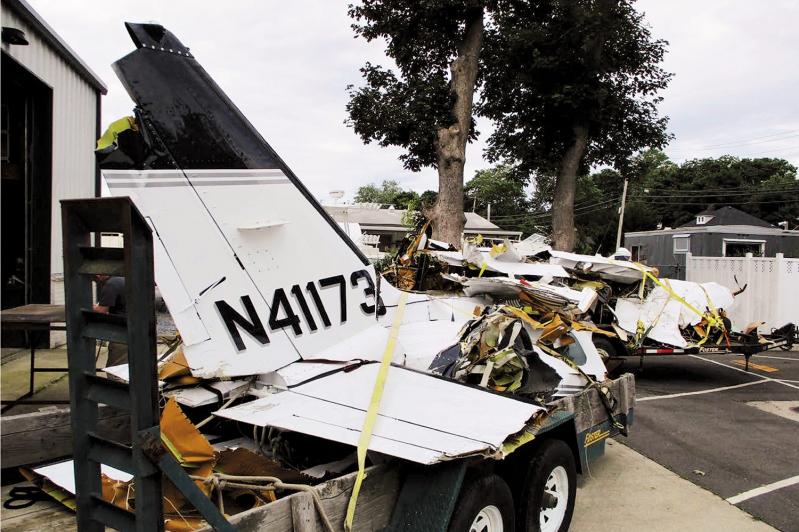The pilot who was flying the small plane that crashed off Amagansett in June of 2018, killing all four people aboard, including Bonnie and Ben Krupinski, last radioed in to air traffic control that he was at 700 feet and “coming in underneath” the thunderstorm, according to the findings of a National Transportation Safety Board investigation.
“Doesn’t look like there’ll be an issue,” Jon Dollard is heard saying next in a 21-second excerpt from his communication with the East Hampton Airport traffic control tower, part of the N.T.S.B.’s report.
The Federal Aviation Administration’s radar data picked up the Piper PA-31-350 Navajo on June 2, 2018, over the Atlantic Ocean, about six miles south of the East Hampton Airport, at an altitude of 432 feet above sea level. It climbed to 512 feet and then descended to 152 feet.
The last radar return at 2:33 p.m. indicated it was at 532 feet at about two miles south of Indian Wells Beach in Amagansett. That is when Jon Dollard, the pilot, told the traffic control tower at East Hampton Airport that he was flying at 700 feet and flying underneath the storm, the N.T.S.B.’s accident factual report said. All communication was then lost.
Mr. Dollard, a 47-year-old pilot from Hampton Bays, and all three passengers aboard — the Krupinskis and their 22-year-old grandson, William Maerov — died in the crash.
The plane was destroyed when it hit the water. The wreckage was found about one mile south of Indian Wells Beach in 50 feet of water. Mr. and Mrs. Krupinski’s bodies were quickly recovered, and Mr. Dollard’s was later recovered. Mr. Maerov’s partial remains were found only in January of 2019.
The report indicates that an autopsy was performed only on the pilot, whose cause of death was blunt force trauma. Forensic toxicology tests were not performed because his body was found two days after the accident.
The report was released quietly in July, and attributed the “defining event” that led to the fatal crash as a “loss of control in flight.”
The plane was one of two in flight from Newport State Airport in Newport, R.I., where the Krupinskis had flown to pick up their granddaughter from prep school. (They took two planes due to the amount of baggage and personal items they would be transporting.) The pilot of the second plane, a Beech Bonanza carrying the teenage girl, told investigators that he and Mr. Dollard talked for about one hour about the weather along the route before departing for East Hampton Airport.
“They both planned to fly south toward Block Island, Rhode Island, then turn west and follow the Long Island shorelines to HTO,” the report said, using the call sign for the East Hampton Airport. They had looked at the weather online.
The Bonanza took off first around 2:10 p.m., then the Navajo. After takeoff, the pilot of the Bonanza, Frank Pinter, contacted air traffic control and was informed that there was a thunderstorm near East Hampton Airport and that it was moving slowly, the report said. Working with air traffic control, Mr. Pinter decided to fly farther south and come into East Hampton Airport, maintaining visual flight rules, according to his interview. He said he flew above 1,000 feet and slowed down because of turbulence. He also told investigators that the storm was to his right and “a little higher.”
“The Bonanza pilot stated that he did not hear the accident pilot on the air traffic control frequency en route, and that, upon contacting the tower controller at HTO, he could hear the controller attempting to contact the accident airplane.”
“Two inflight weather advisories were issued for the route and area of destination about 42 and 15 minutes before the accident, respectfully, and warned of heavy to extreme precipitation associated with thunderstorms,” the report said. There was no record of a weather briefing provided to Mr. Dollard.
The Bonanza landed uneventfully at East Hampton Airport, and that is when Mr. Pinter knew the Navajo was missing. When Mr. Dollard last contacted air traffic control, his plane was five miles ahead of the Bonanza, though it had taken off after it.
“Marginal visual meteorological conditions prevailed,” the report said. “Weather radar had shown a low-pressure system associated with a frontal wave over Long Island Sound with a cold front stretching westward over Long Island into central New Jersey and a warm front turning back to a cold front eastward,” the report said.
Models also indicated scattered thunderstorms over the area. The N.T.S.B. also looked at photographs from a local resident, taken about a half-mile from the accident site, that showed the approaching thunderstorm. Investigators could see “a shelf cloud and cumulus mammatus clouds along the leading edge of the storm, indicative of potential severe turbulence.”
The accident report also details the pilot’s and plane’s information. He held a commercial pilot certificate with ratings for airplane single-engine land, multi-engine land, and instrument airplane. He also held a flight instructor certificate.
Mr. Dollard’s most recent F.A.A. medical certificate was issued on May 30, 2017. At the time of the exam, he reported 3,000 total hours of flight experience. His logbooks were never recovered.
The seven-seat, low-wing airplane was manufactured in 1984 and had last been inspected on Nov. 3, 2017. It had been flown 39 hours since its last annual inspection, the report said.

